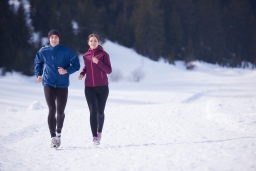Moisture-Wicking Athletic Apparel: A Matter of Style or Performance?
Wednesday, March 21, 2018 - 09:00

Moisture-wicking clothes act to keep athletes cool and dry. Because exercising in the heat can have a severe impact on physical fatigue, companies promote their moisture-wicking products as the difference-maker in these conditions. However, there has yet to be an independent, peer-reviewed study that conclusively demonstrates that performance apparel improves our thermoregulation and performance. How does moisture-wicking work, how does it affect the wearer, and can it actually provide an edge?
How Does Moisture-Wicking Work?
Thermoregulation during exercise is important in order to balance the heat we produce with an appropriate amount of heat loss. The main way we get rid of the excess heat is by evaporation – by sweating. Clothing acts as a barrier to the evaporation of sweat off our skin and into the air. Moisture-wicking fabrics claim to provide better cooling and thermal balance and by reducing moisture accumulation on the skin, they should also increase the comfort of the wearer.
To “wick” is to use capillary action. It is how water and nutrients travel up a tree from its roots, how water appears to climb up a paper towel dipped in water, and how wax rises up the wick of a candle. Simply put, moisture-wicking fabrics involve hydrophilic fibres (hydro=water, philic=love) that draw sweat away from the skin and through the garment to the outer surface where it evaporates. The evaporation on the outer surface drives the shuttling of more water up from the skin and is also one of the reasons for the one-way-only movement.
Is It Better Than Cotton?
Natural fibers like cotton are very absorbent compared to synthetic materials, but are not as efficient in facilitating the transport of moisture to the outer layer to be evaporated. Polyester, one of the most popular moisture-wicking fabrics, while less absorbent, does have this ability to spread and move water vapour away from the skin to help us stay dry. Despite that, in mild to moderate exercise in warm and hot conditions, synthetic fabrics do not provide an advantage over natural fibers in thermoregulation or in performance. Subjectively, most participants did not report a significant difference in comfort or in perceived exhaustion between the synthetic and natural garments, either. In most conditions, we are readily able to maintain our core body temperature, and it is suggested that there needs to be a greater stress to reveal any advantages of evaporative fabric.
When Is Moisture-Wicking Synthetic Apparel Preferable?
Synthetic performance apparel can hold onto odours more than its natural fiber counterpart, and often comes with a hefty price tag. Even so, there may be some situations where it is preferable over non-wicking garments. In colder or windier weather, wet cotton close to your skin can create an “after-chill” effect when it evaporates. Like a wet towel on your skin, it may feel refreshing on a warm day, but in colder conditions, it can cause unwanted – and potentially dangerous – heat loss. Activities where there is significant airflow, such as cycling, have greater convective and evaporative heat loss and combined with wetness on the skin, can leave you feeling cold.
In general, it comes down to personal comfort. Because cotton retains more water than synthetic fabrics, it can feel heavier and wetter. Friction of the wet cotton with skin can also cause discomfort or chafing, especially in activities with rapid or repetitive movements, or if equipment is worn on top. Despite marketing implications, there are no known physiological advantages between different brands of moisture-wicking gear. For recreational and most day-to-day exercise, synthetic apparel will help keep you dry and comfortable, but regardless of the brand, will not enhance your performance.
Sources:
Aschwanden C. 2012. No Sweat: The Truth About Performance Apparel. Consumers Digest.
Capillary action. US Geological Survey.
Davis J, Bishop PA. Impact of clothing on exercise in the heat. Sports Medicine. 2013; 43(8): 695-706.
De Sousa J, Cheatham C, Wittbrodt M. The effects of a moisture-wicking fabric shirt on the physiological and perceptual responses during acute exercise in the heat. Applied Ergonomics. 2014; 45(6): 1447-1453.
Gavin TP. Clothing and thermoregulation during exercise. Sports Medicine. 2003; 33(13): 941-947.
Gavin TP, Babington JP, Harms CA, Ardelt ME, Tanner DA, Stager JM. Clothing fabric does not affect thermoregulation during ex in moderate heat. Medicine & Science in Sports & Exercise. 2001; 33(12): 2124-2130.
Hip Science. 2015, April 26. Moisture Wicking Clothing Explained. Youtube.
Hooper DR, Cook BM, Comstock BA, Szivak TK, Flanagan SD, Looney DP, DuPont WH, Kraemer WJ. Synthetic garments enhance comfort, thermoregulatory response, and athletic performance compared with traditional cotton garments. Journal of Strength and Conditioning. 2015; 29(3): 700-707.
Laing RM, Sims ST, Wilson CA, Niven BE, Cruthers NM. Differences in wearer response to garments for outdoor activity. Ergonomics. 2008; 51(4): 492-510.
Through the Paces: Testing Three Fabrics. Consumers Digest.